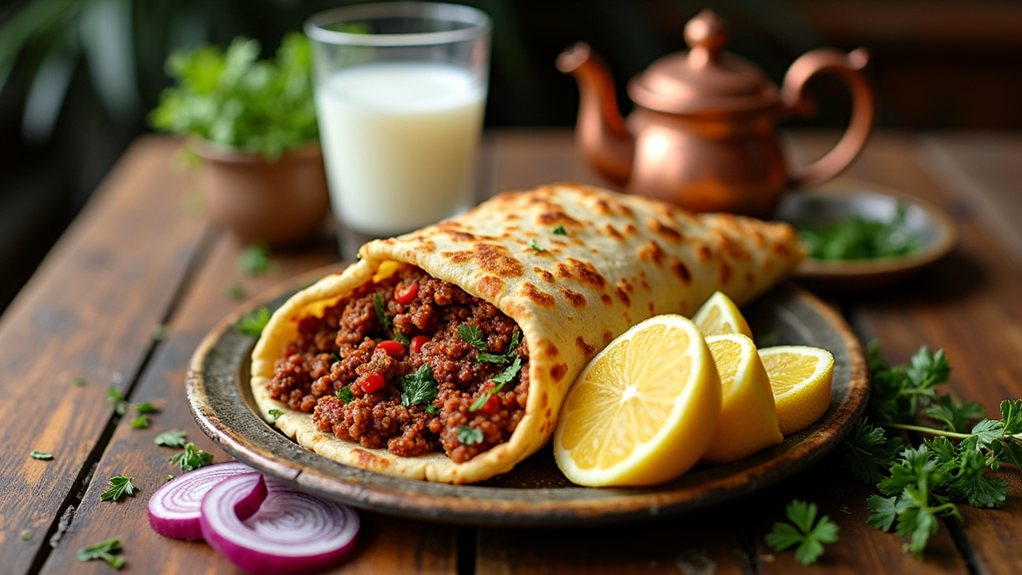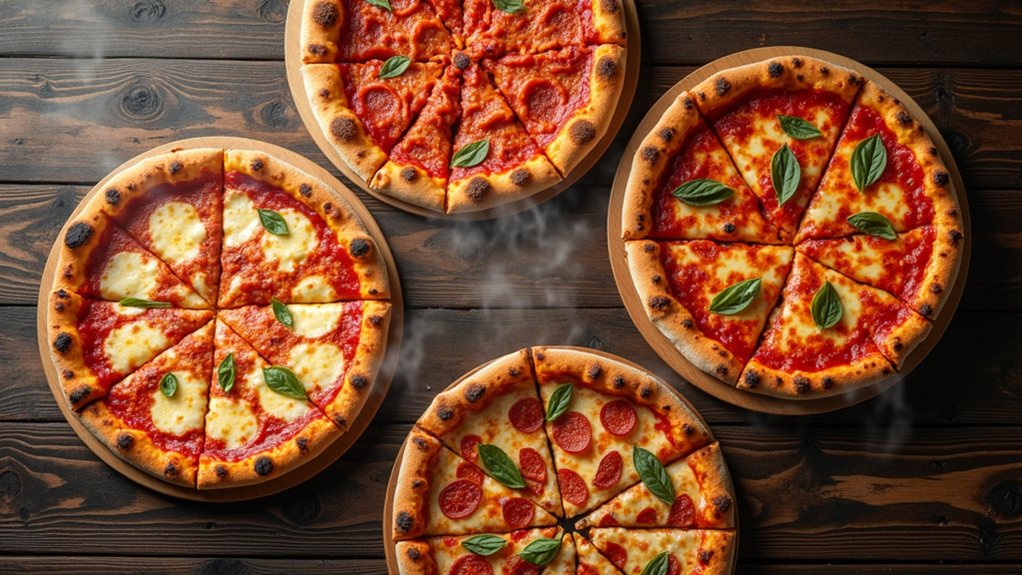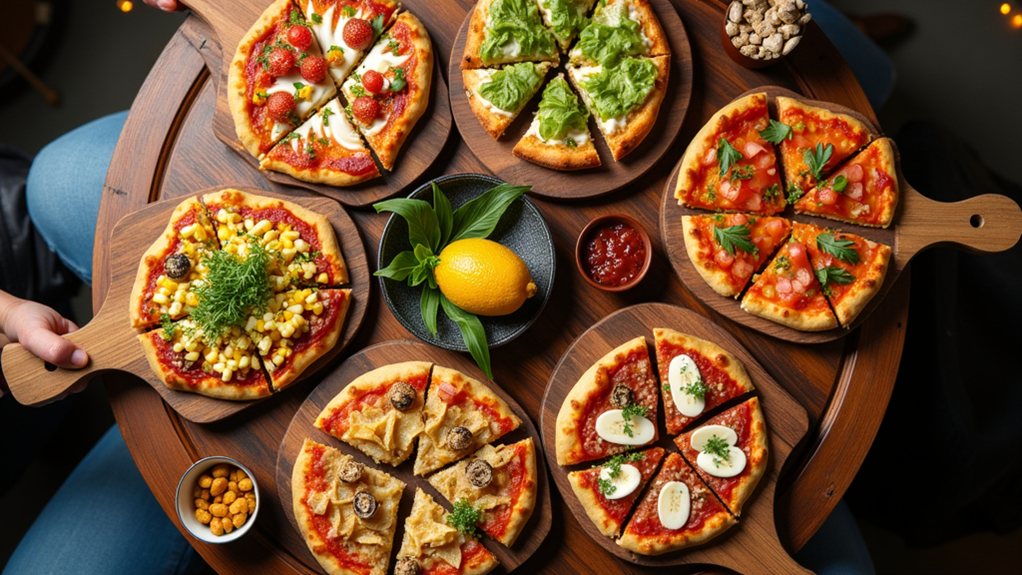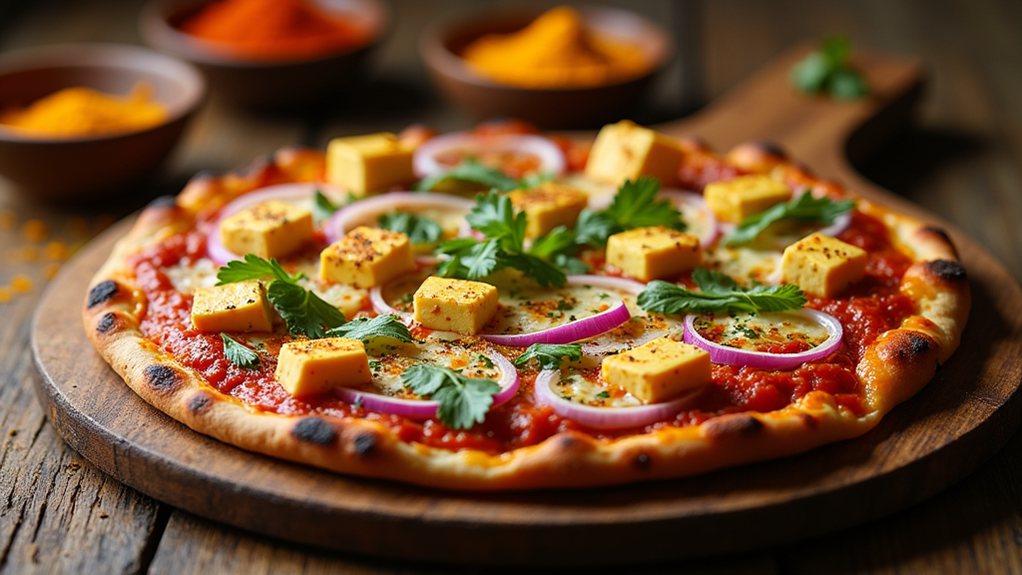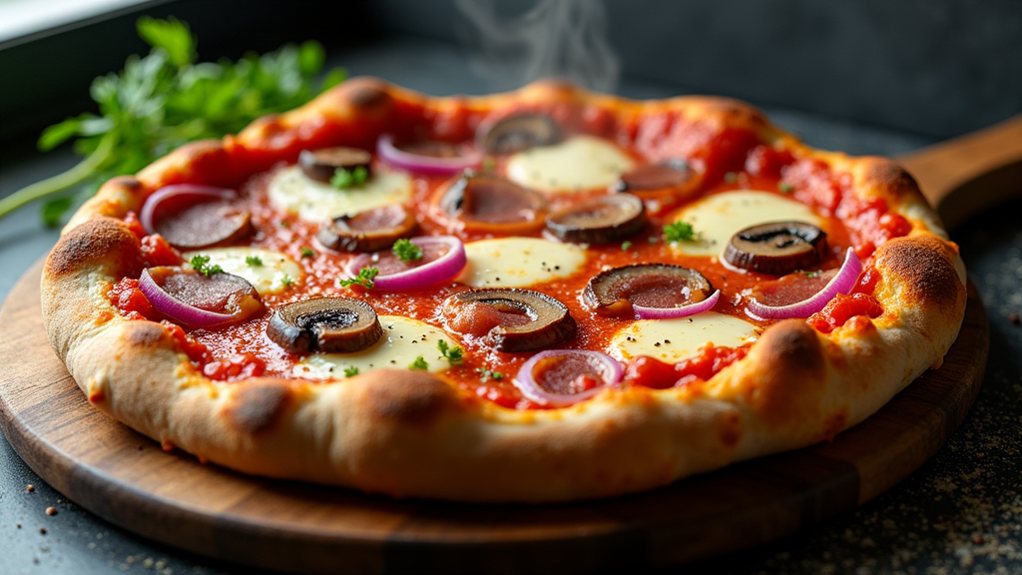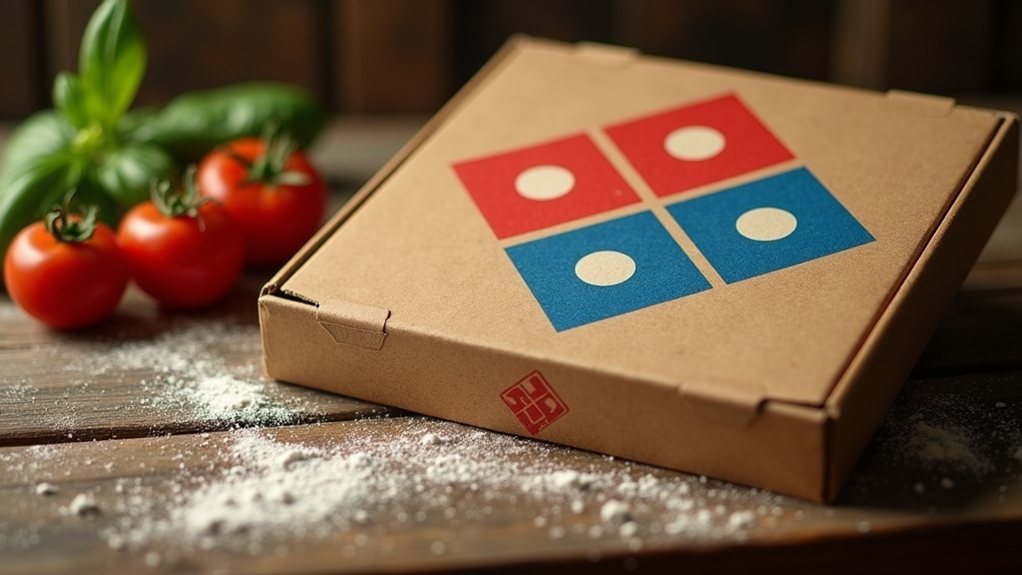Turkish lahmacun offers a culinary expedition that merges simplicity with complex flavors. This "rolled pizza," a staple in Middle Eastern cuisine, features a whisper-thin crust topped with seasoned meat, vibrant herbs, and an essential squeeze of lemon that brightens the entire experience. Its preparation, though seemingly straightforward, requires precision in both dough development and spice balancing. The centuries-old dish continues to evolve across regions, each area adding subtle variations to the classic recipe. What makes this street food truly exceptional, however, lies in its traditional serving method.
The Ancient Origins of Lahmacun
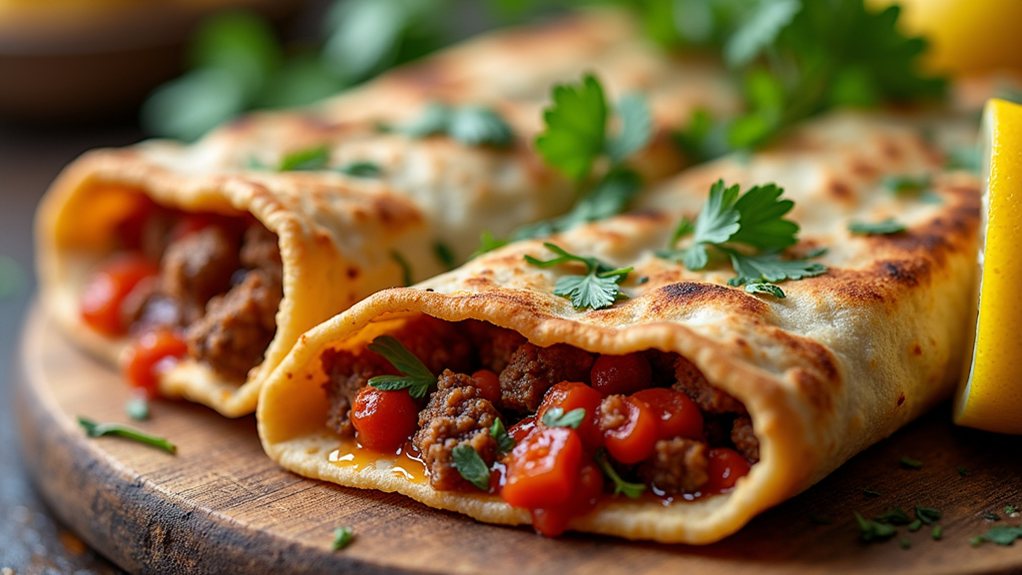
The mystery of lahmacun's birth stretches back through the corridors of time, with its precise origins shrouded in the mists of culinary history.
The ancient origins of lahmacun remain elusive, lost in the shadowy passages of gastronomic antiquity.
This thin, round flatbread topped with minced meat and spices has roots that possibly extend to ancient Babylonia, weaving through the assorted culinary landscapes of the Levant region.
Known by different names including "lahm b'ajin" and "lahmajin," this dish represents centuries of cultural exchange along historic trade routes like the Silk Road.
Originally baked in traditional stone ovens, a practice maintained in many regions today, lahmacun evolved from an elite delicacy to a beloved street food.
The Ottoman Empire played a significant role in its dissemination throughout the Middle East, with Armenian influence so pronounced that the dish is often referred to as "Armenian pizza" in some circles.
Ottoman immigrants introduced this delicious flatbread to South America in the late 19th century, further expanding its global footprint.
Unlike the thick, buttery crust of Chicago-style deep dish pizza, lahmacun features an ultra-thin base that becomes crispy when baked.
Essential Ingredients for Authentic Turkish Lahmacun
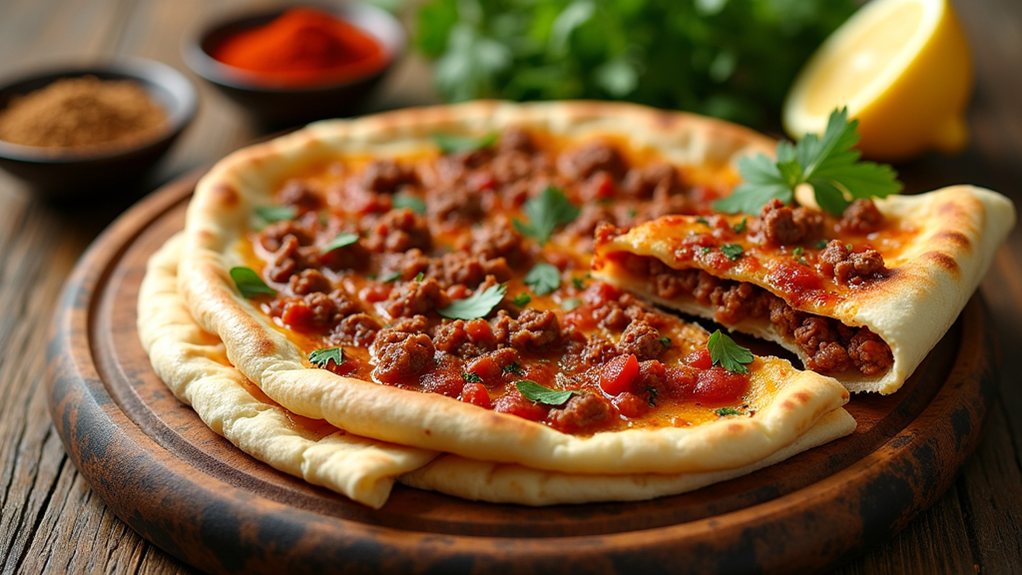
Crafting authentic Turkish lahmacun requires a careful selection of ingredients that balance simplicity with vibrant flavor profiles, creating that distinctive taste beloved across Turkey and beyond. The foundation begins with a thin, crispy dough made from flour, water, salt, and sometimes yeast, which serves as the canvas for the flavorful meat topping. Tipo 00 flour works exceptionally well for achieving the authentic thin crust texture that lahmacun is known for. Fresh vegetables like tomatoes and various pepper varieties are finely chopped and mixed with the meat to create a moist, spreadable topping.
| Ingredient Category | Fundamental Components | Flavor Contribution |
|---|---|---|
| Dough Base | Flour, water, salt | Crispy foundation |
| Meat Mixture | Ground lamb/beef | Rich, savory core |
| Aromatics | Onions, garlic | Depth and pungency |
| Spices | Paprika, cumin, isot | Earthy complexity |
| Fresh Elements | Herbs, lemon wedges | Bright, tangy finish |
The meat topping, typically prepared with ground lamb or beef, incorporates a harmony of spices that creates the signature taste that makes lahmacun distinctively Turkish.
Mastering the Perfect Paper-Thin Dough
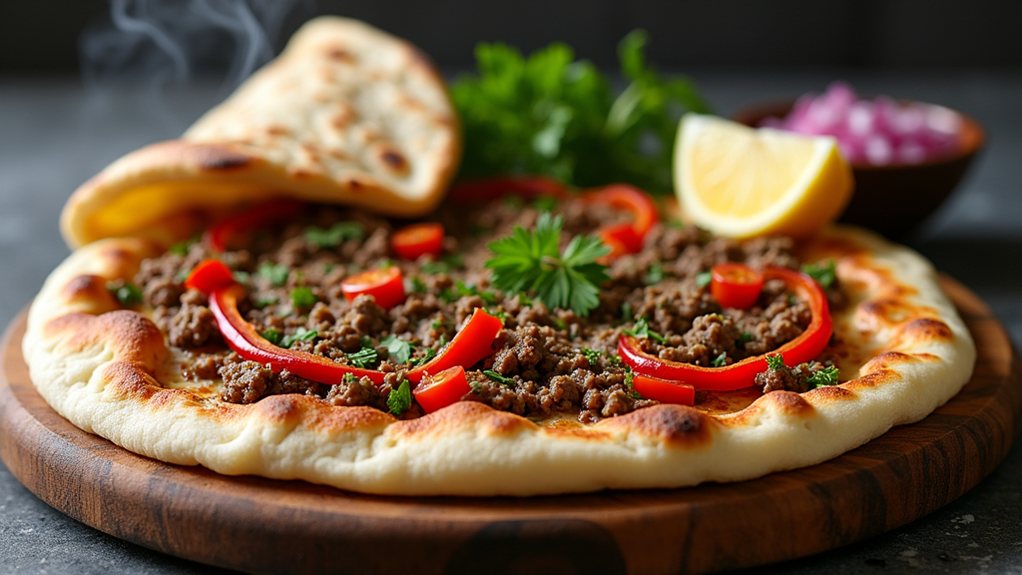
Achieving the perfect paper-thin dough is perhaps the most crucial element when preparing authentic Turkish lahmacun, as this delicate base distinguishes it from other flatbreads found throughout the Mediterranean and Middle East.
Unlike traditional bread, this dough requires no rising time—just a brief 30-minute rest after kneading with lukewarm water and all-purpose flour. Rolling the dough to approximately 6×9 inches demands patience and technique, as thinness directly affects the final crispiness. For optimal results, consider using unbleached flour with higher protein content similar to pizza dough preparation.
When handling lahmacun dough, remember these necessities:
- A well-floured surface to prevent the frustration of sticking
- Gentle, even pressure with a rolling pin to avoid tears in the dough
- A hot oven that transforms your efforts into a perfectly crisp canvas for toppings
Many home bakers find it helpful to cook only two at a time on a baking sheet to ensure even heat distribution and consistent results.
The Art of Spice Blending for Flavorful Toppings
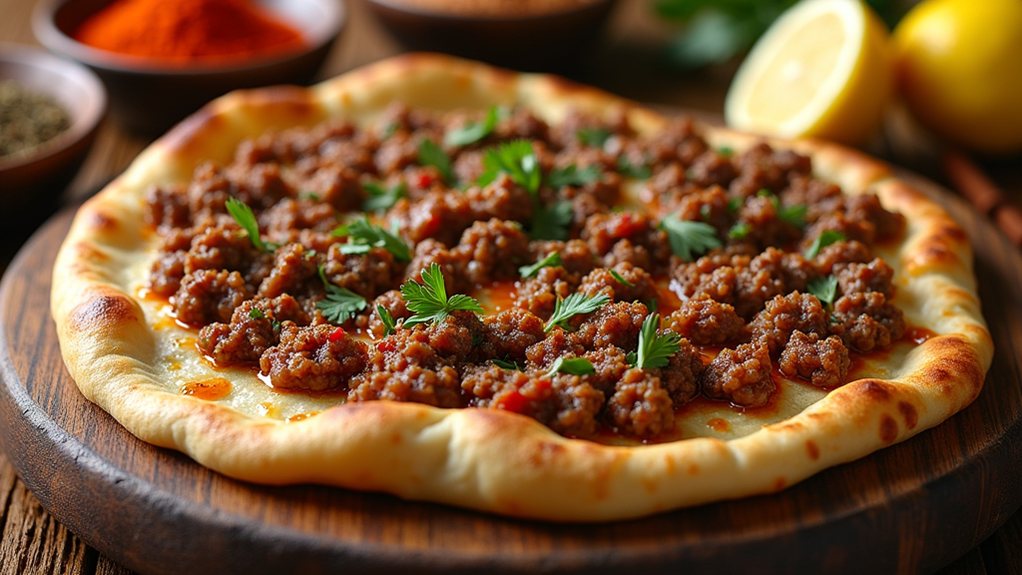
While the delicate dough forms the foundation of any worthy lahmacun, mastering the complex spice blend for the topping transforms this simple flatbread into a symphony of flavors that dance across the palate.
Paprika provides smoky depth, while cumin adds earthy warmth and cinnamon contributes sweetness that balances the heat from Aleppo pepper or cayenne.
Regional variations incorporate distinctive elements like tangy sumac or intense isot pepper, creating unique flavor profiles across different parts of Turkey.
Fresh herbs, particularly parsley and mint, brighten the mixture with their verdant notes, while garlic and onion establish a savory foundation.
Home cooks can enhance their lahmacun by roasting whole spices before grinding, ensuring the aromatic compounds release their full potential.
The perfect balance between spices, herbs, and meat creates a harmonious topping that sings with flavor.
Traditional Baking Methods and Modern Alternatives
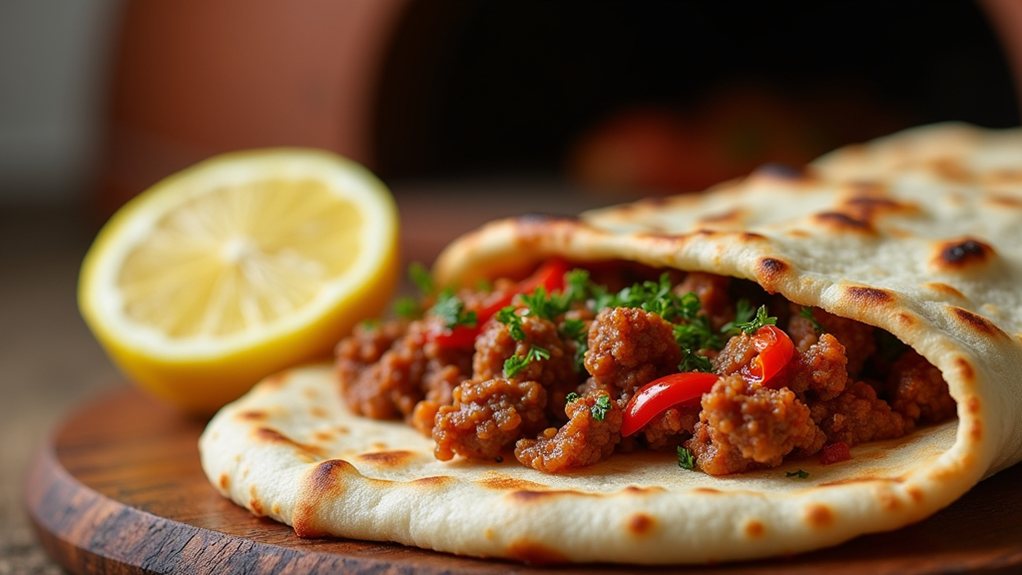
The traditional baking method for lahmacun represents one of the most crucial elements in achieving its distinctive texture and flavor profile.
The alchemy of heat and timing transforms simple ingredients into lahmacun's signature crisp-yet-tender canvas of flavor.
Historically prepared in clay ovens, modern home cooks can recreate similar results using conventional equipment like pizza stones or non-stick pans. The key lies in high-temperature cooking, which allows the base to crisp quickly while the topping cooks through, typically within 1-5 minutes.
Modern alternatives offer flexibility without sacrificing authenticity:
- Preheated ovens set to 500°F transform ordinary kitchens into lahmacun workshops, freeing you from specialized equipment
- Stovetop pans with lids create the vital steam effect, making this Turkish delight accessible anywhere
- Quick-cooking substitutes like tortillas or lavash bread open doors to spontaneous lahmacun creations when time is limited
How to Properly Roll and Enjoy Your Lahmacun
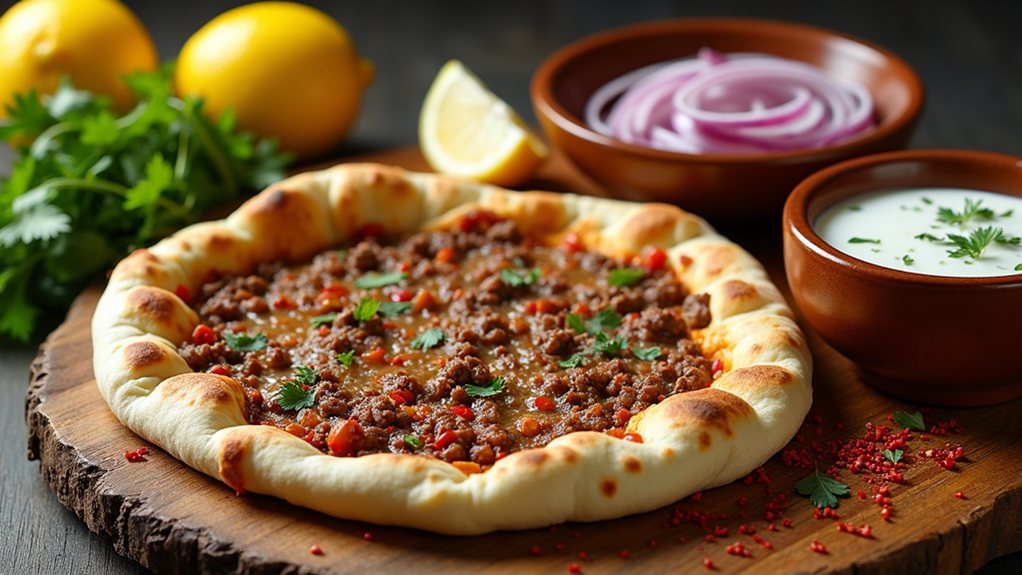
Properly rolling and enjoying lahmacun transforms a simple flatbread into an authentic Turkish culinary experience that delights all the senses. The key to perfect lahmacun lies in its thin, crispy crust rolled immediately after cooking while it remains pliable.
Traditional enjoyment begins with customizing one's lahmacun with fresh herbs, crunchy vegetables, and a squeeze of lemon juice that brightens the spiced meat topping. Many Turkish food enthusiasts pair their rolled creation with a cold glass of Ayran, a yogurt drink that balances the warm spices.
The social aspect of lahmacun cannot be overlooked, as this street food staple brings people together at casual gatherings. Whether enjoyed in bustling Turkish markets or prepared at home, the proper rolling technique—folding it burrito-style—allows for easy handling while preserving the delicate balance of flavors and textures.
Regional Variations Across Turkey and the Middle East
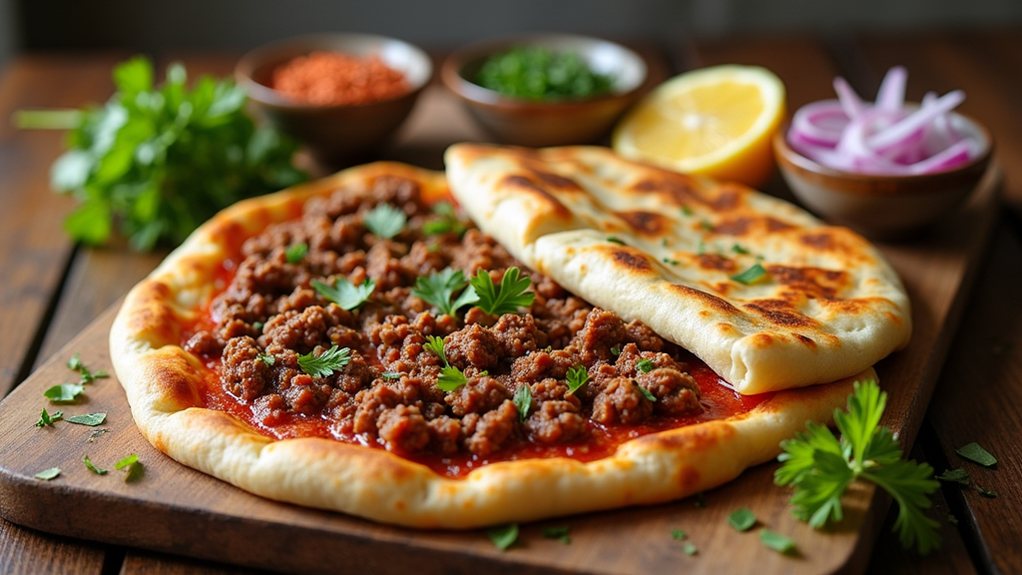
Across Turkey and throughout the Middle East, lahmacun showcases remarkable diversity in its preparation and presentation, with each region contributing unique variations that reflect local agriculture, cultural preferences, and historical influences.
In southeastern Turkey, Urfa-style lahmacun features spicier meat mixtures, while Armenian lahmajoon often incorporates a higher ratio of tomatoes in the topping. Lebanese laham-bi-ajin typically uses a slightly thicker dough compared to its Turkish counterpart.
- The coastal regions along the Mediterranean tend to incorporate more fresh herbs and sometimes seafood elements.
- Mountain villages often feature heartier versions with additional spices to combat cold weather.
- Urban centers have developed fusion variations that blend traditional techniques with contemporary flavors.
The consistent elements—crispy thin crust and savory meat topping—remain the foundation across all regional interpretations.
Pairing Suggestions: From Ayran to Turkish Tea
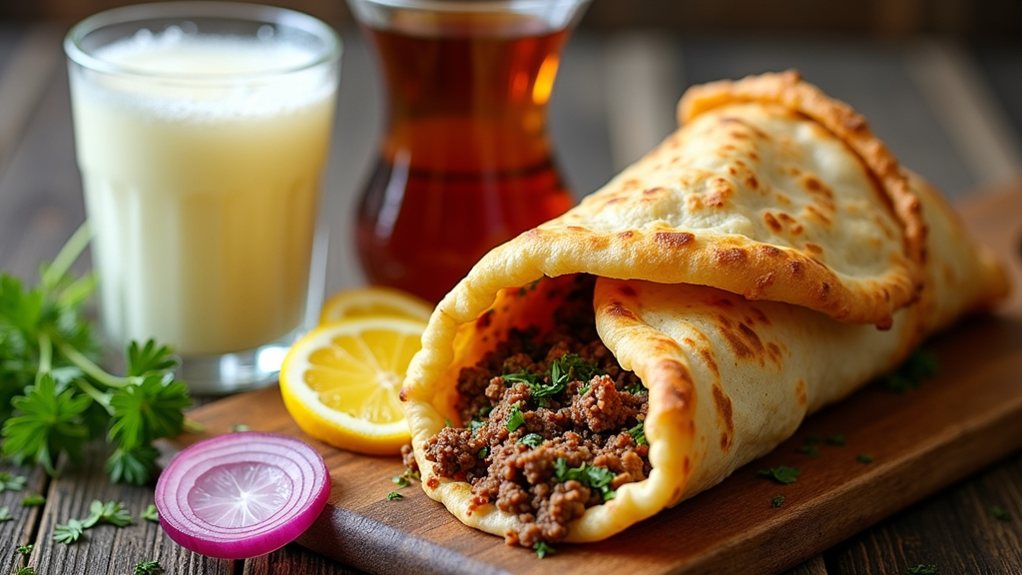
While lahmacun stands brilliantly on its own as a culinary masterpiece, pairing it with the right beverages and accompaniments raises the dining experience to new heights.
Traditional Turkish drinks offer perfect companionship, with ayran, a yogurt-based beverage, complementing the spices in lahmacun while providing cooling relief. Strong black Turkish tea serves as an excellent palate cleanser between bites, cutting through the rich flavors with its distinctive character.
For those seeking invigorating alternatives, diverse lemonade options present delightful contrasts to the savory profile of lahmacun. Classic fresh lemonade delivers sweet-tart balance, while mint and cucumber variations add cooling dimensions that particularly shine during warmer weather.
These thoughtful pairings, deeply rooted in Turkish culinary tradition, transform a simple meal into a complete sensory experience that celebrates the freedom to investigate complementary flavors.
FAQs
Can Lahmacun Be Frozen and Reheated Later?
Yes, lahmacun can be frozen both cooked and uncooked for up to 2-3 months. For reheating, baking at 350-425°F for 10-20 minutes yields ideal results, preserving the crispy texture.
Is Lahmacun Suitable for People With Gluten Intolerance?
Lahmacun is traditionally made with wheat flour containing gluten. However, gluten-free variations using alternative flours like rice, buckwheat, and tapioca starch preserve the authentic flavor while accommodating gluten intolerance.
What Makes Lahmacun Different From Italian Pizza?
Lahmacun differs from Italian pizza through its absence of cheese, use of minced lamb/beef, distinctive Middle Eastern spices, crispy crust, and serving style with fresh vegetables and lemon juice.
How Long Does Homemade Lahmacun Stay Fresh?
Homemade lahmacun remains fresh for 3-4 days when refrigerated in airtight containers. It can be frozen for up to 2 months, allowing individuals to prepare batches in advance without sacrificing quality.
Can Children Help Prepare Lahmacun as a Family Activity?
Children can absolutely help prepare lahmacun as a family activity. They can safely assist with mixing ingredients, shaping dough, and adding toppings while learning cultural cuisine and developing culinary skills.
